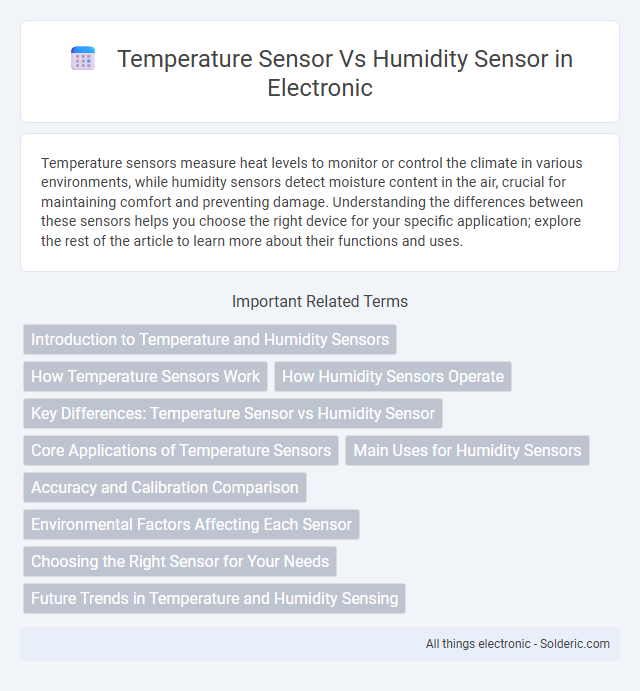Temperature sensors measure heat levels to monitor or control the climate in various environments, while humidity sensors detect moisture content in the air, crucial for maintaining comfort and preventing damage. Understanding the differences between these sensors helps you choose the right device for your specific application; explore the rest of the article to learn more about their functions and uses.
Comparison Table
| Feature | Temperature Sensor | Humidity Sensor |
|---|---|---|
| Primary Function | Measures ambient temperature | Measures atmospheric moisture (humidity) |
| Measurement Unit | degC, degF, K | % Relative Humidity (RH) |
| Common Technologies | Thermocouples, RTDs, Thermistors | Capacitive, Resistive, Thermal Conductivity |
| Applications | HVAC, weather stations, industrial control | Climate control, agriculture, HVAC systems |
| Output Signal | Analog or Digital voltage/current | Analog or Digital voltage/current |
| Response Time | Milliseconds to seconds | Seconds to minutes |
| Accuracy Range | +-0.1degC to +-1degC | +-2% to +-5% RH |
| Environmental Sensitivity | Temperature fluctuations only | Temperature and moisture levels |
Introduction to Temperature and Humidity Sensors
Temperature sensors measure thermal energy to monitor heat variations, crucial for climate control and industrial processes. Humidity sensors detect moisture levels in the air, essential for maintaining optimal indoor air quality and preventing mold growth. Understanding your environment involves using both sensors to achieve accurate and balanced climate management.
How Temperature Sensors Work
Temperature sensors measure thermal energy by detecting changes in physical properties like resistance, voltage, or frequency that vary with temperature. Common types include thermocouples, which generate voltage based on junction temperature differences, and thermistors, which change resistance in response to heat. These sensors convert temperature variations into electrical signals for monitoring and control in HVAC systems, industrial processes, and environmental monitoring.
How Humidity Sensors Operate
Humidity sensors operate by detecting the moisture level in the air through changes in electrical properties such as capacitance or resistance. Capacitive humidity sensors use a hygroscopic dielectric material between two electrodes, where the dielectric constant varies with humidity, altering the capacitance. Resistive humidity sensors measure the change in resistance of a hygroscopic conductive material as it absorbs or releases water vapor.
Key Differences: Temperature Sensor vs Humidity Sensor
Temperature sensors measure thermal energy to determine the degree of heat in an environment, providing data in units like Celsius or Fahrenheit. Humidity sensors detect moisture levels in the air, typically expressed as relative humidity percentage. Key differences include their sensing principles--temperature sensors use thermistors or infrared technologies, while humidity sensors often utilize capacitive or resistive elements--and their specific applications in climate control, weather monitoring, and industrial processes.
Core Applications of Temperature Sensors
Temperature sensors are essential in HVAC systems, ensuring optimal climate control by monitoring and adjusting ambient temperatures. They play a critical role in industrial processes, maintaining machinery within safe operational limits to prevent overheating or freezing. Your temperature sensor also provides vital data in medical devices for accurate patient monitoring and environmental conditions.
Main Uses for Humidity Sensors
Humidity sensors are primarily used to monitor and control moisture levels in environments such as HVAC systems, agriculture, and industrial processes. They help maintain optimal conditions for crop growth, prevent equipment corrosion, and ensure comfortable indoor air quality. Your ability to regulate humidity enhances both product quality and energy efficiency in various applications.
Accuracy and Calibration Comparison
Temperature sensors typically offer higher accuracy and require less frequent calibration compared to humidity sensors, which are more sensitive to environmental changes and contamination. Calibration of temperature sensors often involves fixed reference points like melting ice or boiling water, whereas humidity sensors need complex calibration using saturated salt solutions or controlled humidity chambers. Ensuring your sensors are properly calibrated enhances their reliability for precise environmental monitoring.
Environmental Factors Affecting Each Sensor
Temperature sensors are influenced primarily by ambient thermal conditions, exposure to direct sunlight, and rapid temperature fluctuations, which can cause sensor drift or inaccurate readings. Humidity sensors are affected by moisture levels, condensation, and the presence of contaminants such as dust or chemicals, leading to sensor degradation or offset errors. Both sensor types require proper calibration and environmental shielding to maintain accuracy under varying environmental factors.
Choosing the Right Sensor for Your Needs
Temperature sensors accurately measure thermal variations using thermocouples, RTDs, or thermistors, ideal for applications requiring precise heat monitoring. Humidity sensors detect moisture levels in the air through capacitive or resistive methods, crucial for climate control and agricultural settings. Choose your sensor based on whether monitoring heat fluctuations or ambient moisture best fits your environmental control requirements.
Future Trends in Temperature and Humidity Sensing
Future trends in temperature and humidity sensing emphasize the integration of smart sensor technologies with IoT platforms, enabling real-time environmental monitoring and predictive analytics. Advances in nanomaterials and MEMS (Micro-Electro-Mechanical Systems) are driving the development of ultra-sensitive, low-power sensors with enhanced accuracy and durability. Emerging applications in smart homes, agriculture, and industrial automation are pushing the demand for compact, wireless, and multifunctional temperature and humidity sensors.
temperature sensor vs humidity sensor Infographic

 solderic.com
solderic.com